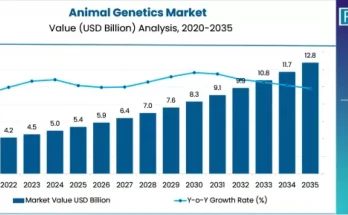The global allergy diagnostics and therapeutics market is set for robust expansion over the next decade, driven by increasing allergy prevalence, accelerated adoption of advanced testing tools, and growing availability of targeted immunotherapies. According to a new analysis by Fact.MR, the market is projected to increase from USD 37.1 billion in 2025 to USD 90.2 billion by 2035, registering an absolute gain of USD 53.1 billion, 143.1% total growth, and a strong CAGR of 9.9% during the forecast period.
Rising cases of asthma, food allergies, allergic rhinitis, dermatitis, and drug allergies—coupled with climate change, pollution, and genetic predisposition—are intensifying global healthcare demand. This surge is further supported by innovations in molecular diagnostics, point-of-care testing, and therapeutic advancements including biologics and sublingual immunotherapy.
Strategic Market Drivers
Allergy Prevalence at All-Time High
Global allergy incidence continues to rise due to worsening air quality, urban living, dietary shifts, and increased exposure to allergens. Healthcare systems worldwide are prioritizing early diagnosis, with skin-prick tests, blood tests (IgE), and molecular assays witnessing significant uptake.
Children and adults alike are increasingly seeking testing for food allergies (peanuts, dairy, shellfish), environmental triggers (pollens, dust mites), and drug allergies, expanding demand across clinical laboratories, hospitals, and specialty centers.
Breakthroughs in Allergy Diagnostics Empower Precision Medicine
The rapid evolution of diagnostics—including component-resolved diagnostics (CRD), multiplex testing panels, and digital allergen profiling—is enabling earlier, more accurate detection. These innovations support personalized treatment planning, reducing adverse reactions and improving clinical outcomes.
Growing preference for home-based and rapid allergy tests is also reshaping patient engagement and accessibility.
Therapeutic Advancements Transform Care Pathways
The therapeutic landscape is progressing rapidly with biologics such as omalizumab and dupilumab, subcutaneous immunotherapy (SCIT), and sublingual immunotherapy (SLIT) offering long-term relief. As R&D investments accelerate, more targeted therapies for asthma, eczema, food allergies, and chronic urticaria are entering development pipelines.
Demand for combination therapies and non-invasive treatment options is further strengthening the market outlook.
Browse Full Report: https://www.factmr.com/report/allergy-diagnostics-and-therapeutics-market
Expanding Healthcare Infrastructure & Awareness Campaigns Boost Penetration
Global awareness campaigns, digital health tools, and school-level allergy management programs are promoting timely diagnosis. Meanwhile, improving access to allergy testing in emerging regions is driving higher patient footfall in clinics and labs.
Insurance coverage expansion for diagnostic testing and biologic treatments is also propelling market uptake.
Regional Growth Highlights
North America: Largest Market with Strong Diagnostic Adoption
North America dominates due to high allergy prevalence, world-class diagnostic infrastructure, and rapid adoption of biologic therapies. The U.S. continues to lead in advanced testing platforms and therapeutic innovation.
Europe: Precision Diagnostics & Immunotherapy Drive Momentum
Europe’s embrace of component-resolved diagnostics, stringent clinical guidelines, and demand for evidence-based immunotherapy support strong market growth across the U.K., Germany, France, and Nordic nations.
East Asia: Urbanization & Pollution Escalate Demand
China, Japan, and South Korea are witnessing increasing allergy cases due to pollution, lifestyle changes, and enhanced healthcare accessibility. Growth in specialized allergy centers and digital health solutions strengthens regional penetration.
Emerging Markets: Massive Untapped Opportunity
India, Southeast Asia, Latin America, and the Middle East present high-growth potential, driven by rising disposable incomes, expanding healthcare networks, and greater awareness of chronic allergic conditions.
Market Segmentation Insights
By Diagnostic Type
- Skin-Prick Tests (SPT) – Widely used for rapid, reliable diagnosis
- Specific IgE Blood Tests – Strong demand for laboratory-based accuracy
- Molecular & Component Testing – Fastest-growing due to precision profiling
- Patch & Challenge Tests – Vital for contact and food allergy assessments
By Therapeutic Type
- Antihistamines & Decongestants – Largest share due to widespread use
- Corticosteroids – Central in respiratory allergy management
- Biologics – Fastest-growing segment, driven by targeted therapies
- Immunotherapy (SLIT & SCIT) – Long-term treatment option gaining strong adoption
By End User
- Hospitals & Clinics – Primary diagnosis & treatment centers
- Diagnostic Laboratories – Leading segment with high test volumes
- Homecare & OTC – Growing through accessible self-testing kits
- Specialty Allergy Centers – Increasing in developed markets
Challenges Influencing Market Growth
- High Cost of Advanced Therapies – Biologics remain expensive in several regions
- Limited Access in Developing Markets – Insufficient allergists and testing facilities
- Complex Reimbursement Processes – Variability impacts testing rates
- Risk of Misdiagnosis – Need for standardization in diagnostic practices
Competitive Landscape
The market is moderately competitive, with companies focusing on molecular diagnostics, immunotherapy innovation, and improved patient experience. Key players are developing next-generation biologics, AI-driven diagnostic tools, and allergy management platforms.
Key Companies Profiled:
• Thermo Fisher Scientific
• Siemens Healthineers
• Danaher Corporation
• Stallergenes Greer
• HAL Allergy Group
• BioMerieux
• NEOGEN Corporation
• Regeneron Pharmaceuticals
• Sanofi
• Roche Diagnostics
Recent investments highlight moves toward automation, expanded testing menus, and integrated allergy care pathways.
Recent Developments
2024: Launch of new AI-based allergy profiling systems and expanded biologic approvals for asthma and dermatitis.
2023: Surge in demand for multiplex allergy testing and home-based diagnostic kits in North America and Europe.
2022: Introduction of safer, faster diagnostic methods and precision immunotherapies tailored for pediatric patients.
Future Outlook: A Decade of Precision Allergy Management
Over the next decade, the global allergy diagnostics and therapeutics market is expected to transform significantly with advancements in biologics, molecular testing, digital monitoring platforms, and personalized treatment protocols. With rising patient awareness and strong investment in healthcare innovation, the industry is poised for unprecedented expansion.
As precision medicine becomes the norm, companies that embrace integrated diagnostics, outcome-driven therapies, and scalable digital ecosystems will lead the future of allergy care worldwide.



